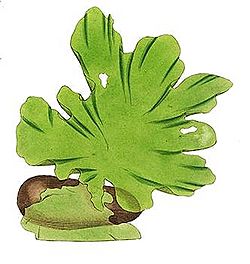Ulvales facts for kids
Quick facts for kids Ulvales |
|
|---|---|
 |
|
| Scientific classification | |
| Domain: | |
| Kingdom: | |
| Division: | |
| Class: | |
| Order: |
Ulvales
|
| Families | |
|
Monostromataceae |
|
Ulvales is an order of green algae. These are simple plant-like living things that mostly grow in the ocean. You might know some of them as "sea lettuce" because they often look like thin, green leaves floating in the water. Ulvales are a very important part of marine (ocean) environments around the world.
Contents
What Are Ulvales?
Ulvales are a type of algae. Algae are not quite plants, but they can make their own food using sunlight, just like plants do. They are green because they contain chlorophyll, the same pigment that makes land plants green. Ulvales are part of a larger group called Chlorophyta, which means "green plants" or "green algae."
Where Do Ulvales Live?
Most Ulvales live in the ocean. You can find them in many different places, from cold polar waters to warm tropical seas. They often grow attached to rocks, shells, or other surfaces in shallow coastal areas. Some types can even float freely in the water. A few kinds of Ulvales can also live in fresh water, like lakes and rivers.
What Do Ulvales Look Like?
Ulvales come in various shapes and sizes, but many are known for being flat and sheet-like.
- One of the most famous Ulvales is Ulva lactuca, also called "sea lettuce." It looks like a thin, wavy green leaf.
- Other Ulvales might be tube-shaped or have tiny, branched structures.
- They can range in size from very small, almost invisible to the eye, to larger forms that can be several feet long.
- Despite their different shapes, they all share similar cell structures and ways of growing.
How Do Ulvales Reproduce?
Ulvales have interesting ways to make new algae. They can reproduce both sexually and asexually.
- Asexual reproduction means they can make copies of themselves without needing another Ulvales. This often happens when a piece breaks off and grows into a new alga.
- Sexual reproduction involves special cells called gametes coming together. This process often involves two different forms of the alga, one that makes male gametes and one that makes female gametes. This helps create new combinations of genes, which can help them adapt to different environments.
Why Are Ulvales Important?
Ulvales play a big role in ocean ecosystems.
- Food Source: Many small marine animals, like snails and crabs, eat Ulvales. They are also eaten by some fish.
- Oxygen Production: Like all green plants and algae, Ulvales perform photosynthesis. This means they take in carbon dioxide and release oxygen, which is vital for all living things on Earth.
- Habitat: Large beds of Ulvales can provide shelter and a home for small fish and other marine creatures.
- Human Uses: Some types of Ulvales, especially sea lettuce, are eaten by people in various parts of the world. They are used in salads, soups, and as a healthy snack. They are full of vitamins and minerals.
Famous Ulvales
The most well-known genus (a group of similar species) in the Ulvales order is Ulva.
- Ulva species are found worldwide and are often the ones called "sea lettuce."
- They can grow very quickly, especially in areas with lots of nutrients.
- Sometimes, if there are too many nutrients in the water (from pollution, for example), Ulva can grow so much that it forms large "green tides." These can cover beaches and cause problems for other marine life.
Ulvales are simple but amazing organisms that are a key part of our planet's aquatic environments.
See also
 In Spanish: Ulvales para niños
In Spanish: Ulvales para niños

